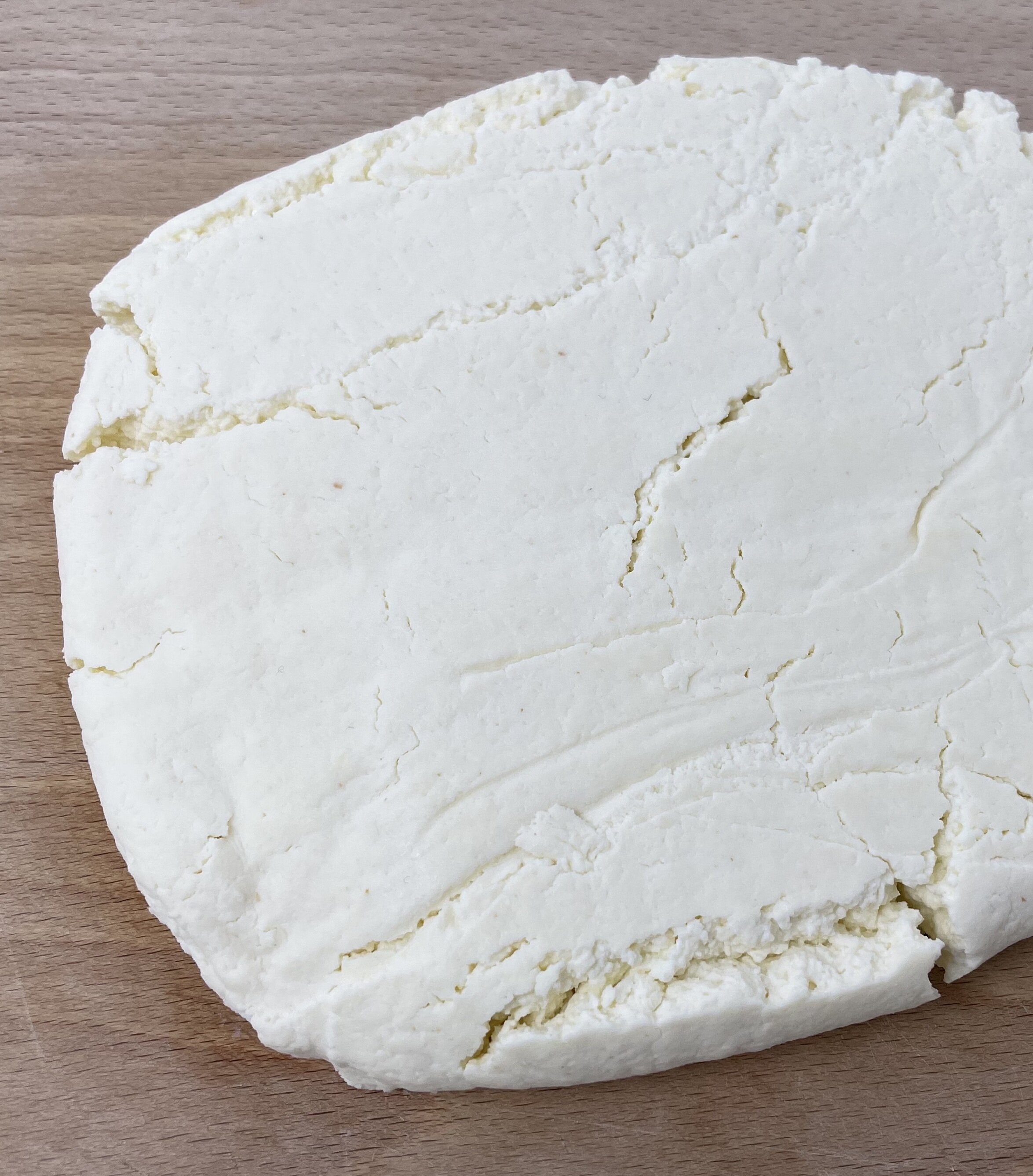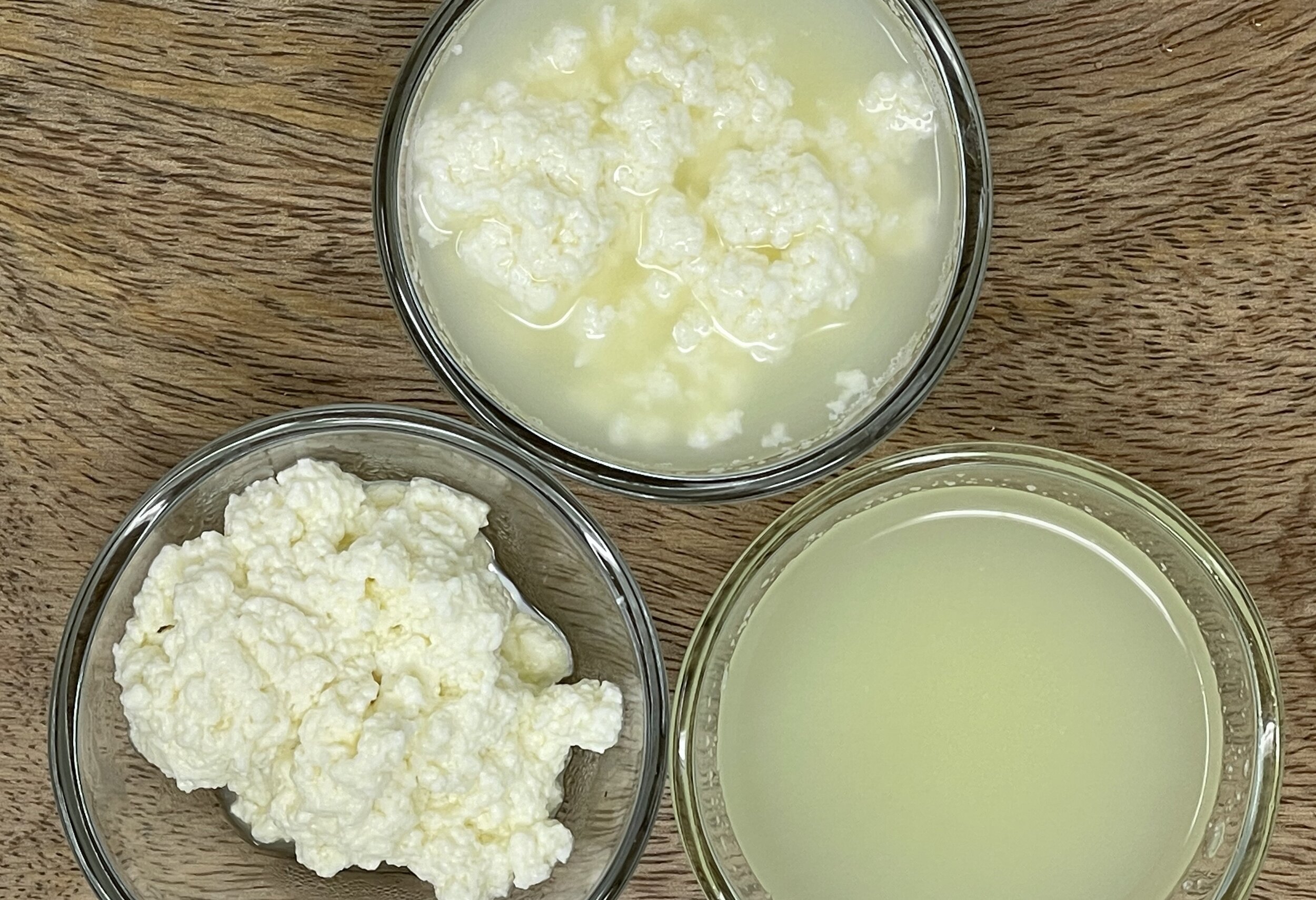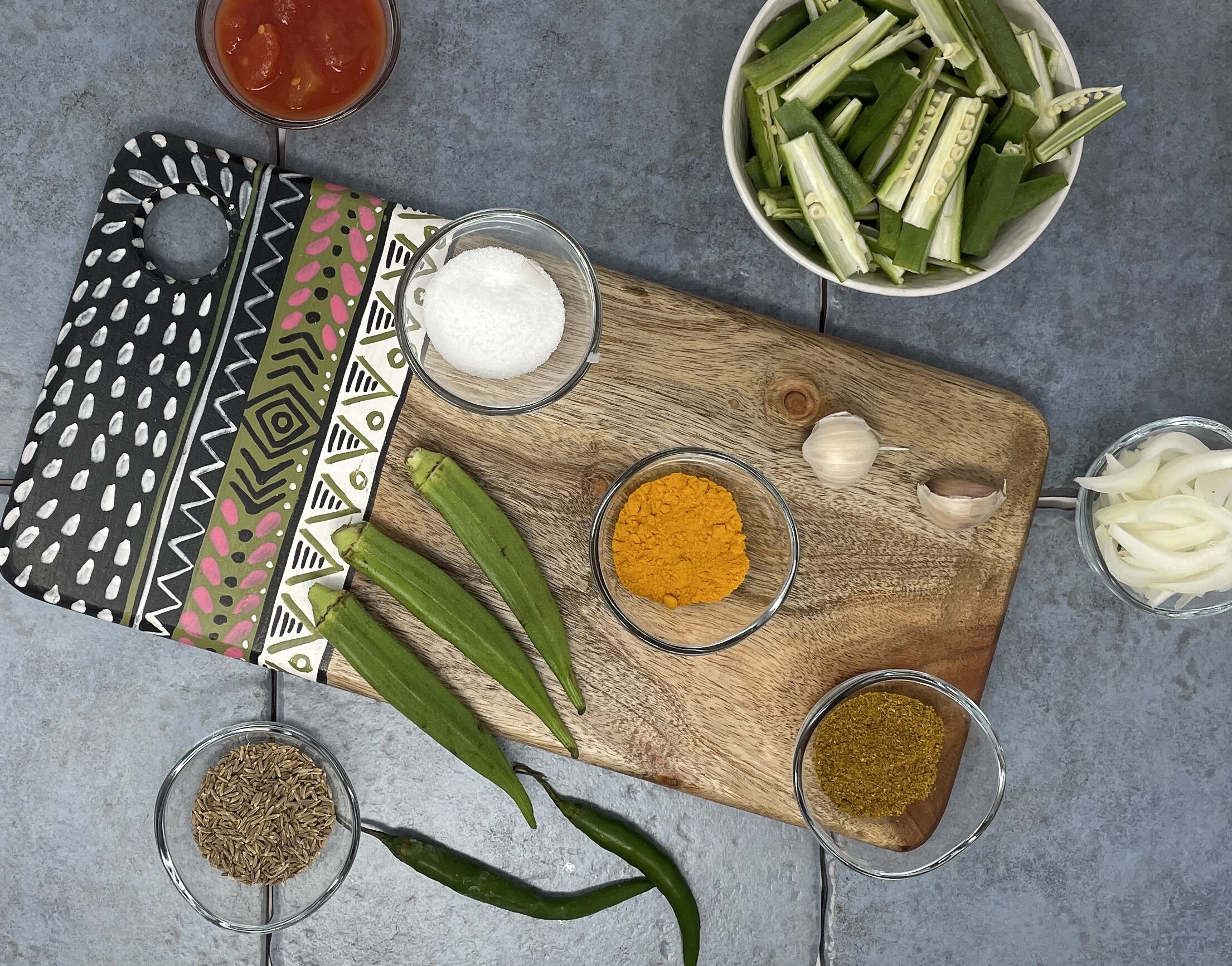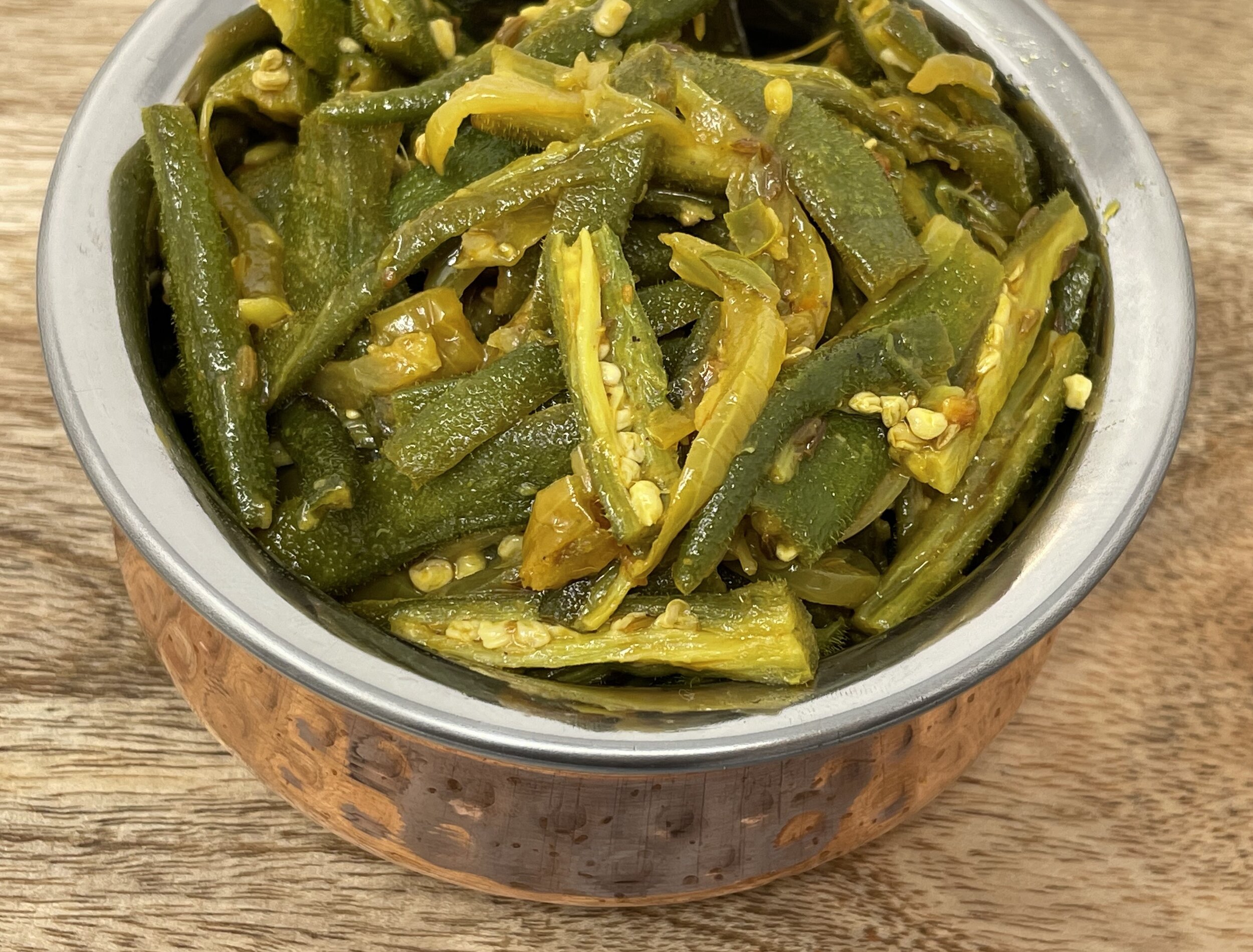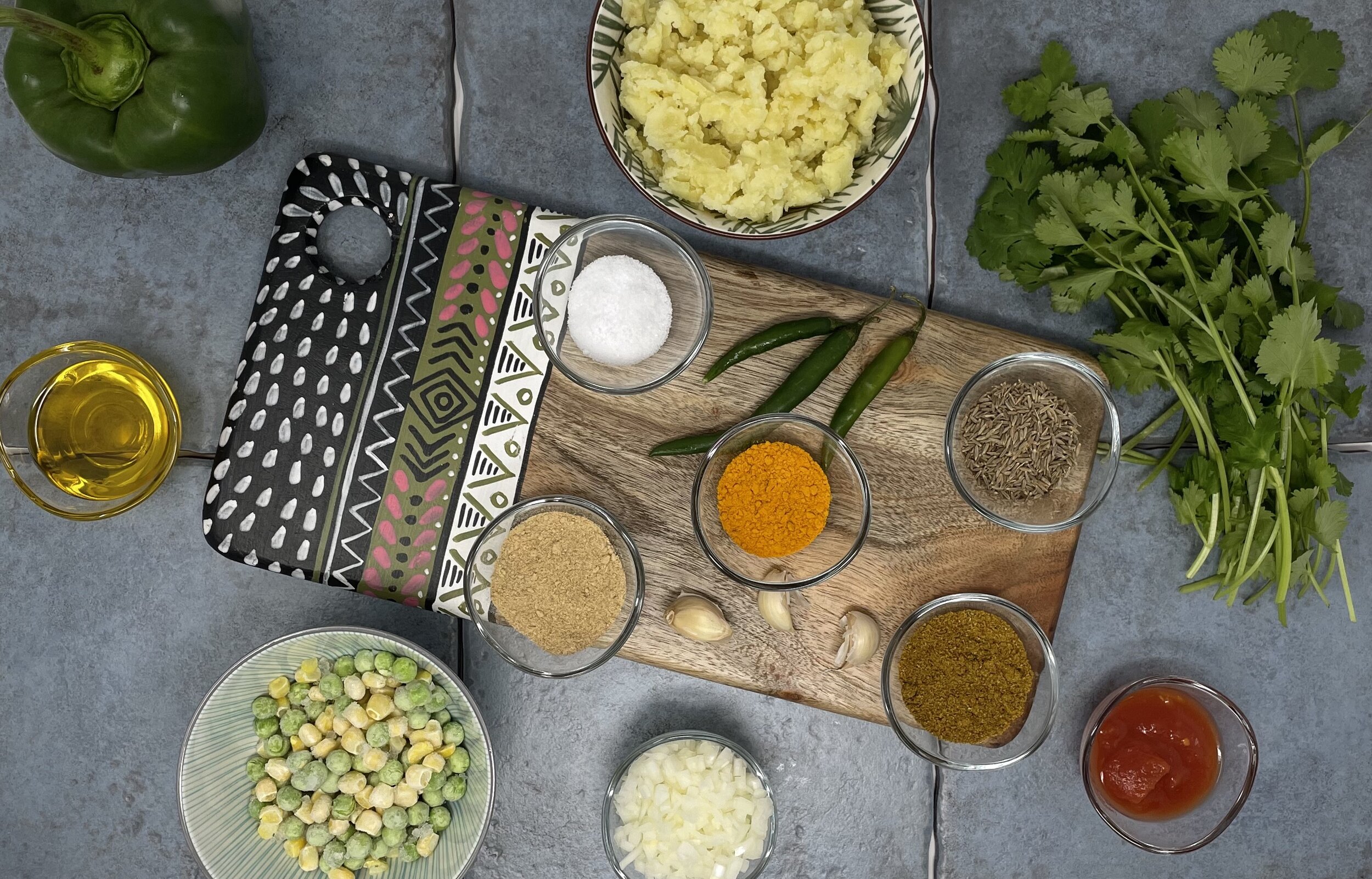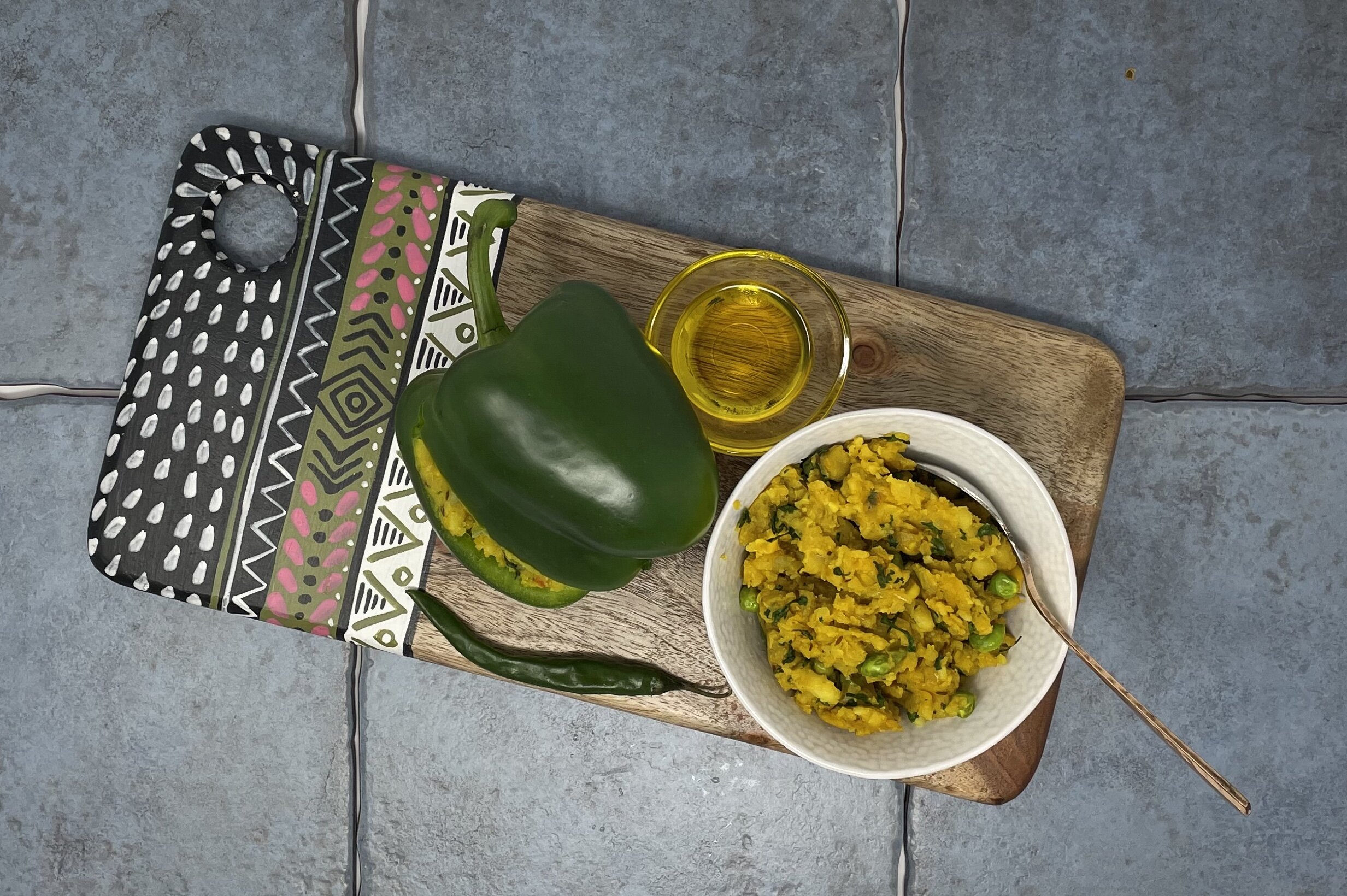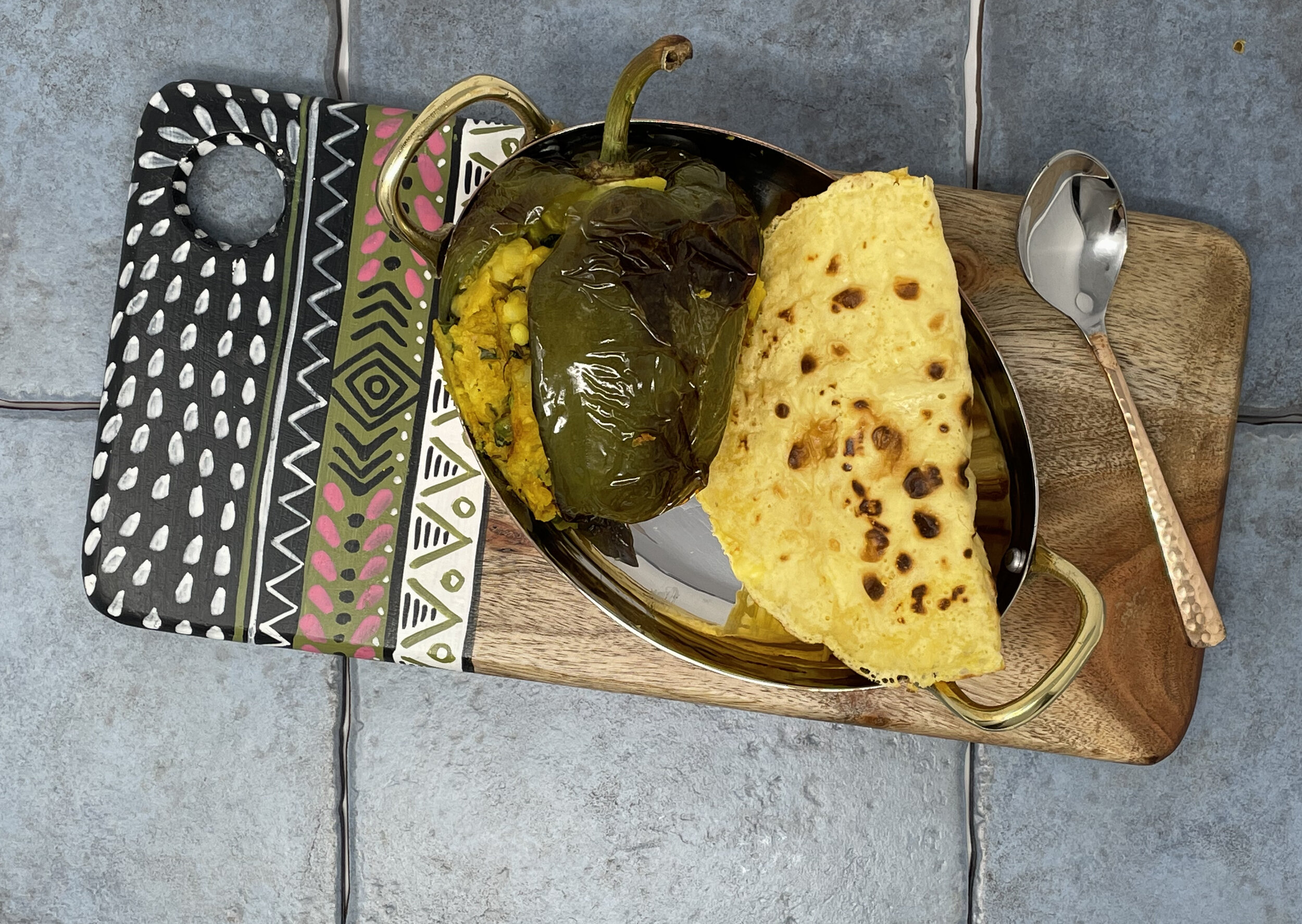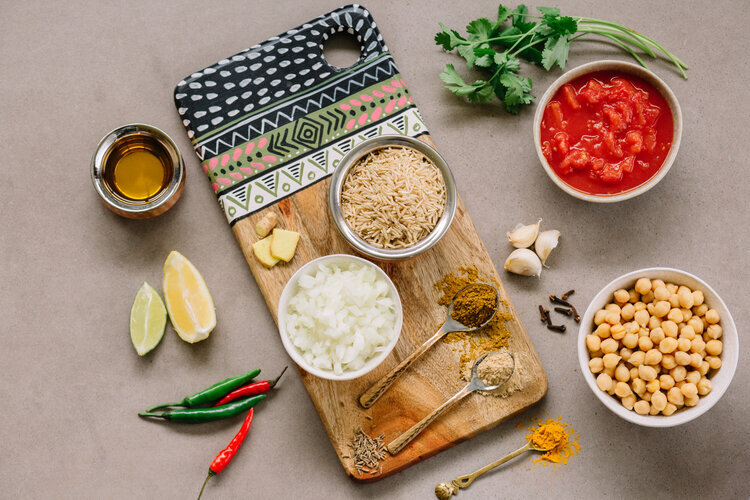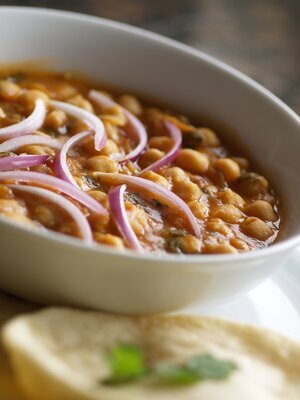Gluten Free Aloo Paranthas
Makes: 6
Total cooking and preparation time: Around 65 minutes (potato boiling 20 - 25 minutes, making the filling 15 minutes, making the paranthas approximately 25 minutes)
NB: The preparation of spring onions, garlic, chillies and the roti dough can be carried out whilst the potatoes are boiling.
Suitable for: Vegetarians, Vegans (use vegetable oil, not ghee, to brush/fry each side of parantha)
Serve piping hot with any curry and mint and coriander chutney.
Gluten free aloo parantha…
Ingredients:
One portion of gluten free roti dough
300g waxy potatoes such as new potatoes, charlotte potatoes
1 bunch of spring onions, chopped
2 tablespoons rapeseed oil
1 teaspoon of whole cumin
1 clove garlic, finely grated/crushed
½ green chilli, finely chopped
1 teaspoon salt
¼ - ½ teaspoon of haldi (turmeric)
¼ teaspoon garam masala
¼ teaspoon of amchoor (dried mango powder)
Half a handful of chopped coriander leaves
Butter/ghee/vegetable oil to brush each side of the parantha
Method:
Potato Filling:
Wash the potatoes and place them in a pan. Add enough water to just cover the top of the potatoes. Bring to the boil, turn down the heat to simmering, cover the pan and simmer until the potatoes can be ‘pierced’ readily with the tip of a knife. Should take about 20-25 minutes.
Drain the water and peel the potatoes, lightly mash with a potato masher or fork. Set aside.
Heat the oil in a frying pan, add the cumin and let it rise until it splutters.
Add the chopped onions, fry on medium heat for 5 minutes or until softened.
Add the garlic, chillies and spices. Stir for a few minutes.
Add the mashed potatoes and stir until the onion mixture and potatoes are evenly mixed.
Continue to cook on low to medium heat, stirring occasionally until the potato mixture easily comes away from the frying pan.
Add the chopped coriander and mix it through the potato filling above. Cook for a further two minutes.
Remove the potato filling from the pan and spread out on a plate to cool down.
Making the Paranthas:
Place the tawa or frying pan on the hob and place on a medium to hot setting.
Knead the gluten free roti dough once again for a couple of minutes.
Divide the dough into 12 equal pieces.
Using two pieces of the divided dough, knead each one again using the palm of one hand and the fingers of the other hand to form two balls. Flatten each ball slightly with your fingertips then roll out each piece to form two circles roughly 2½ inches in diameter.
Place approximately 45g of potato filling in the centre of one of the cirlces. Place the second piece over the filling. Seal the edges by pinching along the whole circumference.
Press down lightly with your fingertips to flatten further.
Dust each side with dry flour and use a rolling pin to create a thin circle of about 7 inches in diameter.
Place the parantha on the hot tawa and allow it to cook on one side for a couple of minutes. Turn the parantha over and allow the still-raw side to cook for a few minutes, checking a couple of times and pressing lightly around the edges if needed.
Turn the parantha back over once the second side is fully cooked and coat the cooked side of the parantha with some ghee (c. ¼ teaspoon). Turn the parantha over once again and repeat the ghee coating process on this other side. Turn over once more and gently cook for a further 30 seconds or so. The parantha should be crisp on both sides, but soft in the middle.
Remove from the tawa and place the parantha on a clean tea towel folded over on a warm plate.
Repeat steps 4 to 10 until all paranthas have been made.
Serve hot.
Ras Malai
Serves 4 - 5
Suitable for: Vegetarians and those on a gluten free diet
Preparation time: 15 minutes plus time for making paneer
Cooking time: 40 minutes Chilling time: 6 hours
A very popular dish for festive occasions
Ingredients:
200g paneer
1 teaspoon arrowroot or cornflour
For water syrup:
200g granulated sugar
800ml water
¼ teaspoon of crushed green cardamom seeds
For the ras malai (milk syrup):
500ml whole milk
60g granulated sugar
¼ - ½ teaspoon of crushed green cardamom seeds
10g sliced pistachios
pinch saffron strands
Method:
Place 200g of paneer in a bowl and knead for about 3 -5 minutes until it is smooth. Add the arrowroot and knead for a couple more minutes to incorporate.
divide the kneaded paneer into 8 - 10 balls each weighing c. 20g
knead each ball in the palm of one hand using the fingers of the other hand to form a ball, flatten slightly to form thick ‘discs’ and keep aside. Repeat with remaining balls
Pour 800ml of water in a large, wide pan (paneer ‘discs’ with increase in size during this process), add 200g of sugar. Dissolve the sugar and bring syrup to a rolling boil. Turn down the heat a touch ensuring the syrup is continues to boil.
Add the paneer ‘discs’ to the syrup gently, cover the pan and allow the rolling water to cook the paneer for 15 minutes. Half way through, gently stir the syrup around the paneer ‘discs’ taking care to avoid touching the discs themselves as these will crumble..
In the mean time make the milk syrup (malai). Pour the milk into a pan and heat. Place 4 tablespoon of warm milk in a bowl with a few strands of saffron, mix and keep aside. Add the crushed cardamoms and bring the rest of the milk to the boil and boil gently for 10 minutes.
When the paneer discs are cooked, remove them gently and place them in a flat bottomed bowl together with some of the syrup and allow to cool
Going back to the milk syrup, add the sugar and continue boiling for a further 10 minutes. Add the saffron infused milk and most of the sliced pistachios keeping some aside to garnish. Boil for a further 5 minutes.
Lift one of the cooked paneer ‘discs’ out of the syrup, gently squeeze between two spatulas to allow excess syrup to run off. Place the disc in another flat bottomed bowl. Repeat with the remaining discs in the syrup and arrange them into the bowl.
Pour over the milk syrup, garnish with the remaining sliced pistachios, allow to cool and refrigerate for at least 6 hours.
Serve and enjoy.
Gluten Free Gobi Paranthas
Makes: 6 Paranthas
Preparation time: 15 minutes. Resting time: 10 minutes
Rolling out/cooking time: approx. 25 minutes
Suitable for: Vegetarians, Vegans (use a vegetable oil to brush each side of parantha) and those on a gluten free diet
Serve piping hot with any curry. I’ve partnered them with bhangan bhartha here.
Ingredients:
200g gluten free chapati flour (I use Eurostar Food Gluten Free flour)
120g finely grated gobi florets
1 clove garlic, finely grated
½ - 1 green chilli, finely chopped
¾ teaspoon salt
¼ teaspoon of haldi (turmeric)
¼ teaspoon garam masala
1 tablespoon of plant based milk (dairy for non-vegans)
40 water
Extra gluten free chapati flour for dusting and rolling out
Oil to brush each side of the parantha (ghee can be used by non-vegans)
Method:
Place the flour in a bowl, add the milk and combine.grated cauliflower, garlic, chilli and dry spices.
Add the grated cauliflower, garlic, chilli and dry spices. Mix the contents together until a crumb like consistency forms
Pour a small amount of water to form a pliable dough.
Knead for a few minutes until the dough feels smooth, dipping your fingers in the water to add additional water if needed.
Cover the bowl with cling film and allow the dough to rest for 10 minutes or so.
Place the tawa or frying pan on the hob and heat on a medium to hot setting
Knead the dough once again for a couple of minutes then divide into six portions. If the dough feels too soft at this stage, roll it in thin dusting of dry chapati flour.
Starting with one portion, knead this again using your hands to form a ball and then flatten slightly with your fingertips.
Dust each side and roll out into a circular parantha approximately 6 inches in diameter using additional flour to dust where needed
Place the parantha on the hot tawa and allow it to cook partially on one side for a couple of minutes. Turn the parantha over and allow this (raw) side to cook for a few minutes checking a couple of times and pressing lightly around the edges if needed to ensure this side is fully cooked.
Turn the parantha back over once this side is fully cooked and coat the cooked side of the parantha with some ghee (c. ¼ teaspoon). Turn the parantha over once again and repeat the ghee coating process on this other side. Turn over once more and gently cook for a further 30 seconds or so. The parantha should be crisp on both sides yet soft in the middle
Remove from the tawa and place the parantha in a clean tea towel folded over on a warm plate.
Repeat steps 8 to 12 until all paranthas have been made.
Serve hot
Roti (Chapati) Dough
Makes one portion sufficient for 6 - 7 rotis; 6 - 8 aloo paranthas
Preparation time: 5 minutes. Resting time: 15 minutes
Suitable for: Vegetarians Vegans (use a vegetable oil instead of ghee or butter in the recipe)
Ingredients:
200g chapati flour (I use white or medium chapati flour. Wholemeal chapati flour is also available)
1 tablespoon milk, optional
100 ml water
Method:
Add the milk, if using, to the flour in a bowl and mix until combined
Pour a small amount of water to the flour at a time to form a pliable dough.
Knead for a few minutes until the dough feels smooth, dipping your fingers in the water to add additional water if needed.
Cover the bowl with cling film and allow it to rest for 15 minutes or so.
Use as required.
Aloo (Potato) Paranthas
Makes: 6 - 8 paranthas
Total cooking and preparation time: Around 65 minutes (potato boiling 20 - 25 minutes, making the filling 15 minutes, making the paranthas approximately 25 minutes)
NB: The preparation of spring onions, garlic, chillies and the roti dough can be carried out whilst the potatoes are boiling.
Suitable for: Vegetarians, Vegans (use vegetable oil, not ghee, to brush/fry each side of parantha)
Serve piping hot with any curry and mint and coriander chutney.
Ingredients:
One portion of Roti Dough
300g waxy potatoes such as new potatoes, charlotte potatoes
1 bunch of spring onions, chopped
2 tablespoons rapeseed oil
1 teaspoon of whole cumin
1 clove garlic, finely grated/crushed
½ green chilli, finely chopped
1 teaspoon salt
¼ - ½ teaspoon of haldi (turmeric)
¼ teaspoon garam masala
¼ teaspoon of amchoor (dried mango powder)
small handful of chopped coriander leaves
Butter/ghee/vegetable oil to brush each side of the parantha
Method:
Potato Filling:
Wash the potatoes and place them in a pan. Add enough water to just cover the top of the potatoes. Bring to the boil, turn down the heat to simmering, cover the pan and simmer until the potatoes can be ‘pierced’ readily with the tip of a knife. Should take about 20-25 minutes.
Drain the water and peel the potatoes, lightly mash with a potato masher or fork. Set aside.
Heat the oil in a frying pan, add the cumin and let it rise until it splutters.
Add the chopped onions, fry on medium heat for 5 minutes or until softened.
Add the garlic, chillies and spices. Stir for a few minutes.
Add the mashed potatoes and stir until the onion mixture and potatoes are evenly mixed.
Continue to cook on low to medium heat, stirring occasionally until the potato mixture easily comes away from the frying pan.
Add the chopped coriander and mix it through the potato filling above. Cook for a further two minutes.
Remove the potato filling from the pan and spread out on a plate to cool down.
Making the Paranthas:
Place the tawa or frying pan on the hob and place on a medium to hot setting.
Knead the roti dough once again for a couple of minutes.
Break two pieces of approximately 25g each from the dough.
Using these two pieces, knead each one separately again using the palm of one hand and the fingers of the other hand to form two balls. Flatten each ball slightly with your fingertips then roll out each piece to form two circles roughly 2½ inches in diameter.
Place approximately 45g of potato filling in the centre of one of the flattened dough pieces. Place the second piece over the filling. Seal the edges by pinching along the whole circumference.
Press down lightly with your fingertips to flatten further.
Dust each side with dry flour and use a rolling pin to create a thin circle of about 7 inches in diameter.
Place the parantha on the hot tawa and allow it to cook on one side for a couple of minutes. Turn the parantha over and allow the still-raw side to cook for a few minutes, checking a couple of times and pressing lightly around the edges if needed.
Turn the parantha back over once the second side is fully cooked and coat the cooked side of the parantha with some ghee (c. ¼ teaspoon). Turn the parantha over once again and repeat the ghee coating process on this other side. Turn over once more and gently cook for a further 30 seconds or so. The parantha should be crisp on both sides, but soft in the middle.
Remove from the tawa and place the parantha on a clean tea towel folded over on a warm plate.
Repeat steps 3 to 10 until all paranthas have been made.
Serve hot.
Chutney ‘Sandwich’ Paneer and Tofu (Vegan) Pakoras
Serve as a Starter or a Snack
Makes 15 - 18
Preparation time: 15 minutes. Frying time: about 20 minutes
Plus time for making paneer and chutney.
Paneer version: Vegetarians and those on a gluten free diet
Tofu version: Vegetarians, vegans and those on a gluten free diet
Enjoy piping hot as a starter to a meal or a snack or starter on their own or with a chutney.
Ingredients:
150g gram flour
150ml cold water
2 cloves of garlic, crushed
2 - 3 green chillies, chopped finely
1½ level teaspoons of salt
¼ teaspoon of turmeric
¼ teaspoon of garam masala
1 finely sliced spring onion (optional)
½ teaspoon amchoor (dried mango powder) or 2 teaspoons lemon/lime
250g paneer or tofu (for vegans)
One portion Mint & Coriander Chutney
Vegetable oil for deep fat frying
Batter:
Sieve the gram flour into a bowl
Add the water and whisk to form a smooth thick batter
Add the garlic, chillies, turmeric, salt, garam masala amchoor/lemon juice and mix thoroughly.
Cover and set aside for about an hour
Preparation of the Paneer:
Cut the paneer or tofu into triangular or diamond shapes about 2cm deep. Slice each piece in half and spread a layer of chutney (2mm) in between the two creating a sandwich.
Putting it all together:
Place the oil in a karai or wok/deep fat fryer no more than one third full. Heat on medium to high heat. Test the oil to see if it hot enough to fry by placing a drop of the batter into the oil. If the ball of batter rises within a second or two, the oil is hot enough.
Re-whisk the batter.
Dip the chutney paneer or tofu sandwich in the batter and coat on all sides Gently slide the coated ‘sandwich’ into the oil.
Repeat step 3 above until the number of ‘sandwiches’ that your karai can hold at any one time ensuring there is sufficient room to turn the paneer pakoras over easily.
When the pakoras begin to rise to the surface, gently turn them over. Continue turning them over every so often until they are evenly golden and crisp on both sides.
Gently remove from the oil, draining any excess oil back into karai and place on a warm plate lined with absorbent kitchen paper.
Repeat process from No. 3 above for the remaining cubes of paneer.
Serve hot on their own or with a chutney
Mint & Coriander Chutney
Serves 4
Preparation time: 20 minutes
Suitable for: Vegetarians, vegans and those on an gluten free diet
Serve with Pakoras, Paneer Pakoras, Vegetable Fritters and any of the paranthas.
Use also to make an alternative version of the Paneer Pakoras, Chutney ‘Sandwich’ Paneer Pakoras
Ingredients:
1 shallot (chopped)
40g mint leaves
40g coriander leaves
½ - 1 green chilli
1 teaspoon of ground cumin dry roasted for a few minutes
½ teaspoon of salt
½ teaspoon of sugar
½ inch of fresh ginger (peeled)
1 clove of garlic (optional)
Juice of half a lemon
Method:
Thoroughly wash the mint and coriander leaves.
place the ground cumin in a hot frying pan and dry roast for a minute or two, stirring to avoid it burning.
Place all the ingredients in a blender and blend until smooth.
Taste and adjust salt, chilli, sugar and/or lemon juice content according to taste.
Place in a bowl and refrigerate. Flavour improves when allowed to rest for an hour or so.
Batter for Vegetable Fritters
Makes 20
Preparation time: 15 minutes.
Suitable for: Vegetarians, Vegans and those on a gluten free diet
Ingredients:
150g gram flour
150ml cold water
2 cloves of garlic, crushed
2 green chillies, chopped finely
1½ level teaspoons of salt
¼ teaspoon of turmeric
¼ teaspoon of garam masala
1 finely sliced spring onion, including the green parts (optional)
½ teaspoon amchoor (dried mango powder) or 2 teaspoons lemon/lime, optional
Method:
Batter:
Sieve the gram flour into a bowl
Add the water and whisk to form a smooth thick batter
Add the garlic, chillies, turmeric, salt and garam masala and mix thoroughly.
Cover and set aside for 30 minutes.
Paneer/Halloumi Pakoras
Serve as a Starter or a Snack
Makes 24
Preparation time: 15 minutes. Frying time: about 20 minutes
Suitable for: Vegetarians and those on a gluten free diet
Enjoy piping hot as a starter to a meal or a snack or starter on their own or with a chutney.
Ingredients:
150g gram flour
150ml cold water
2 cloves of garlic, crushed
2 - 3 green chillies, chopped finely
1½ level teaspoons of salt
¼ teaspoon of turmeric
¼ teaspoon of garam masala
1 finely sliced spring onion (optional)
½ teaspoon amchoor (dried mango powder) or 2 teaspoons lemon/lime
250g paneer or Halloumi cheese
Vegetable oil for deep fat frying
Batter:
Sieve the gram flour into a bowl
Add the water and whisk to form a smooth thick batter
Add the garlic, chillies, turmeric, salt, garam masala amchoor/lemon juice and mix thoroughly.
Cover and set aside for about an hour
Preparation of the Paneer:
Cut the paneer/halloumi into cubes c. 2cm - 2.5cm by 1 cm deep and keep aside
Putting it all together:
Place the oil in a karai or wok/deep fat fryer no more than one third full. Heat on medium to high heat. Test the oil to see if it hot enough to fry by placing a drop of the batter into the oil. If the ball of batter rises within a second or two, the oil is hot enough.
Re-whisk the batter.
Place a cube of paneer/halloumi into the batter, coat on all sides and gently slide the coated paneer/halloumi into the oil.
Repeat step 3 above until the number of coated paneer cubes that your karai can hold at any one time ensuring there is sufficient room to turn the paneer pakoras over easily.
When the pakoras begin to rise to the surface, gently turn them over. Continue turning them over every so often until they are evenly golden and crisp on both sides.
Gently remove from the oil, draining any excess oil back into karai and place on a warm plate lined with absorbent kitchen paper.
Repeat process from No. 3 above for the remaining cubes of paneer.
Serve hot on their own or with a chutney
Paneer
Makes 340g
Preparation time: 20 minutes Draining/Weighing Down Time: 50 minutes
Suitable for: Vegetarians and those on a Gluten-Free diet
Use to make such dishes as Saag Paneer, Mutter Paneer, Ras Malai, Paneer Pakoras, Chutney ‘Sandwich’ Paneer Pakoras, Ras Malai
NB: Paneer cubes for the curries and paneer pakoras should be roughly 15 - 20mm thick (height) but they should be about 30mm thick for the sandwich pakoras to allow for slicing in half horizontally to form the sandwich.
Ingredients:
2 litres of whole milk (I use organic whole milk)
3½ tablespoons of lemon juice (1 lemon) OR ½ teaspoon of citric acid
Method:
Rinse a heavy based saucepan with water to prevent the milk solids from sticking to the bottom
Pour the milk into the pan and bring to the boil on fairly high heat
Turn off the heat the as soon as the milk begins to reach boiling point otherwise it will boil over.
Add the lemon juice and stir continuously until the curd separates from the whey
Turn the heat back on onto a slow/medium setting and allow to come just up to boiling point.
Turn off heat and drain the contents through a metal sieve over a large bowl - the whey can be used for making cakes, biscuits or discarded
Rinse the curd with cold water.
Leave the curd in the sieve over the bowl for 20 minutes to drain off any excess whey/water.
Transfer the drained curd into a bowl and knead for a couple of minutes until it forms a thick cream like texture
Spread a piece of linen over a dry clean chopping board. Form a soft rough ball with the kneaded curd.
Place in the centre of the linen, flatten to about 15cm in diameter.
Wrap the linen around this flattened curd.
Place the linen wrapped curd in the centre of a clean absorbent tea towel and wrap the tea towel around the linen containing the curd.
Place a heavy weight over the wrapped curd - these could be tins of pulses, tins of tomatoes in a flat bottomed pan.
Leave to let the excess whey drain out of the curd for half an hour.
Unwrap the paneer and use as desired.
Bhindi (Okra)
Serves: 4 as a side dish or 2 - 3 as a main dish
Preparation time: 20 minutes.
Cooking time: 30 minutes
Suitable for: Vegetarians, vegans and those on a gluten free diet
Serve piping hot with rotis/paranthas; a dal dish; rice and yoghurt (plant based if vegan)
Ingredients:
500g fresh okra
40ml vegetable oil
1 teaspoon jeera (cumin seeds)
2 medium onions, sliced thinly lengthways
1 medium tomato, skinned and chopped roughly or 2 level tablespoon canned chopped tomatoes
1 - 2 green chillies, chopped finely
2 cloves of garlic, crushed
1¼ - 1½ level teaspoons of salt
½ teaspoon of turmeric
¼ teaspoon of garam masala
¼ teaspoon of amchur or 1 teaspoon of lemon juice, optional
Method:
Wash the bhindi, drain and dry each individual bhindi with a clean tea towel.
Top and tail each bhindi, cut in half horizontally and then quarter each half vertically.
Make the tarka which is less time consuming than for other curries because of the lower tomato/moisture content.
Heat the oil (butter or ghee) on medium heat until fairly hot (be careful with butter/ghee as these have lower smoking points). Add the cumin seeds and cloves and stir until they splutter (virtually immediately)
Turn the heat down to low/medium, add the onions and fry gently stirring occasionally until they soften.
Add the tomatoes, salt, turmeric, chillies, garlic, ginger stir. Continue to cook gently, ‘mashing’ the tomatoes until a paste like consistency forms. I use a potato masher.
Add the garam masala, stir and cook for a further minute or so or until oil oozes out of the paste when a wooden spoon is dragged along the base of the pan
Add the prepared okra and combine with the tarka.
With the heat on medium, place the lid on the pan keeping it slightly ajar. Simmer for about 10 minutes stirring occasionally.
After 10 minutes or so, the contents may start sticking to the bottom of the pan. At this time, remove the lid completely, turn down the heat a touch and continue cooking, stirring occasionally until the oil starts to ooze (another 5 minutes or so).
When cooked, add the amchur or lemon juice if using - this takes away the ‘sliminess’, stir for a minute or so.
Turn off the heat and serve hot.
Gobi Paranthas (Cauliflower Paranthas)
Makes: 6 paranthas
Preparation time: 15 minutes. Resting time: 10 minutes
Rolling out/cooking time: approx. 25 minutes
Suitable for: Vegetarians and vegans (use a vegetable oil to brush each side of parantha)
Serve piping hot with any curry. I’ve partnered them with bhindi and yoghurt here.
Ingredients:
200g chapati flour (I use white or medium chapati flour. Wholemeal chapati flour is also available)
120g finely grated gobi florets
1 clove garlic, finely grated
½ green chilli, finely chopped
¾ teaspoon salt
¼ teaspoon of haldi (turmeric)
¼ teaspoon garam masala
50 - 60ml water
Extra chapati flour for dusting and rolling out
butter/ghee/vegetable oil to brush each side of the parantha
Method:
Place the flour in a bowl, add the grated cauliflower, garlic, chilli and dry spices.
Mix the contents together until a crumb like consistency forms
Pour a small amount of water to form a pliable dough.
Knead for a few minutes until the dough feels smooth, dipping your fingers in the water to add additional water if needed.
Cover the bowl with cling film and allow the dough to rest for 10 minutes or so.
Place the tawa or frying pan on the hob and heat on a medium to hot setting
Knead the dough once again for a couple of minutes then divide into six portions (approximately 65 - 70g in weight). If the dough feels too soft at this stage, roll it in thin dusting of dry chapati flour.
Starting with one portion, knead this again using your hands to form a ball and then flatten slightly with your fingertips.
Dust each side and roll out into a round roti approximately 6 inches in diameter using additional flour to dust where needed
Place the parantha on the hot tawa and allow it to cook partially on one side for a couple of minutes. Turn the parantha over and allow this (raw) side to cook for a few minutes checking a couple of times and pressing lightly around the edges if needed to ensure this side is fully cooked.
Turn the parantha back over once this side is fully cooked and coat the cooked side of the parantha with some ghee (c. ¼ teaspoon). Turn the parantha over once again and repeat the ghee coating process on this other side. Turn over once more and gently cook for a further 30 seconds or so. The parantha should be crisp on both sides yet soft in the middle
Remove from the tawa and place the parantha in a clean tea towel folded over on a warm plate.
Repeat steps 8 to 12 until all paranthas have been made.
Serve hot
Roti (traditional chapati)
Makes: 6 rotis
Preparation time: 5 minutes. Resting time: 15 minutes
Rolling out/cooking time: approx. 15 minutes
Suitable for: Vegetarians and vegans (use a vegetable oil to brush one side of the chapati)
Serve piping hot with any curry
Ingredients:
One portion of Roti Dough
Extra chapati flour for dusting
butter/ghee/vegetable oil to brush one side of the chapati
Method:
Make the roti dough.
Place the tawa or frying pan on the hob and heat on a medium to hot setting
Knead the dough once again for a couple of minutes then divide into six portions approximately 65 - 70g in weight each.
Starting with one portion, knead this again using your hands to form a ball and then flatten slightly with your fingertips.
Dust each side and roll out into a thin circular roti approximately 7 inches in diameter using additional flour to dust where needed
Place the roti on the hot tawa and partially cook for a minute. Turn the roti over and allow this (raw) side to cook for a couple of minutes checking to see if cooked, pressing lightly around the edges with a clean tea towel or kitchen paper.
Turn the roti back over once this side is fully cooked. Gently press on and around the roti surface until the roti puffs up. At this point the originally partially cooked side will also now be fully cooked.
Remove from the tawa and place the roti onto one half of a clean tea towel on a warm plate and brush one side of the roti with ghee, butter or oil. Cover with the other half of the tea towel to keep the rotis warm whilst making the rest.
Repeat steps 7 to 11 until all rotis have been made.
Serve hot
Stuffed Peppers
A yummy spicy alternative to the traditional rice stuffed peppers…
Serves: 4
Preparation time: 25 minutes including time taken to boil the potatoes and make the base which can be done side by side)
Baking time: 45 to 60 minutes at 190°C/375°F/Gas mark 5
Suitable for: Vegetarians, vegans and those on a gluten free diet
Serve piping hot with traditional wheat flour roti or paranthas, a dal dish; rice and yoghurt (plant based if vegan)
Ingredients:
4 small green peppers
1 tablespoon of vegetable oil
1 bunch of spring onions or one small onion
1 medium tomato, skinned and chopped roughly or 1 tablespoon of canned chopped tomatoes
1 green chilli, chopped finely
2 cloves of garlic, crushed
500g new potatoes or other waxy potato variety
1¾ level teaspoons of salt
½ teaspoon of turmeric
¼ teaspoon of garam masala
½ teaspoon of amchoor (dried mango powder)
40g frozen sweetcorn, defrosted
40g frozen peas, defrosted
handful of chopped coriander
Method:
Add enough water to the potatoes in the pan to cover the potatoes and about half an inch above. Bring to he boil, then cover and simmer gently until soft (20 minutes).
Drain, cool, peel off the skins and mash
In the meantime, chop the spring onions finely and gently fry in the oil until they soften.
Add the chopped tomato, salt, garlic, chilli and haldi. Stir to incorporate and continue cooking gently for a couple of minutes. Add the garam masala and amchoor and stir again.
Add the defrosted sweetcorn and peas and cook gently for a few minutes. Then add the mashed potatoes stir to combine all the ingredients together. Cook on low heat stirring occasionally for about 10 minutes.
Add the coriander and combine into the potato filling. Cook for a couple of minutes. Take off the heat and set aside
Turn the oven on at 190°C/375°F/Gas mark 5
Wash and dry the peppers. Slit in half keeping the peppers intact at the stalk end. Scoop out the seeds
Divide the potato filling into 4 portions and stuff each pepper. Once filled, press the two halves of each pepper together to form one pepper again.
Brush the outside of each pepper with vegetable oil, place on a baking tray lined with aluminium foil and bake in the preheated oven for 45 - 60 minutes (depending on how ‘well done’ you prefer your peppers) turning the peppers over half way through baking time. The skin should be charred, crisp and brown in places.
Remove from the oven and serve. I serve these with a dhal of some sort, plain boiled brown rice and roti either traditional wheat flour or besan if gluten free.
Fine Beans and Potato Curry
Serves: 4
Preparation time: 45 minutes. Cooking time: 45 minute
Suitable for: Vegetarians, vegans and those on a gluten free diet
Serve piping hot with traditional wheat flour roti or paranthas, a dal dish; rice and yoghurt (plant based if vegan)
Ingredients:
Tarka:
40ml vegetable oil
1 tablespoon cumin seeds
2 small onions, finely sliced
50g tinned tomatoes or medium sized fresh tomato, skinned and chopped
2 - 3 chillies (green finger), chopped finely
2 level teaspoons salt
½ - ¾ teaspoon haldi (turmeric) - add the higher amount if using fresh tomatoes
2 cloves of garlic, crushed
½ teaspoon of garam masala
2 cloves of garlic, crushed
Curry:
400g of fine beans, topped/tailed, chopped finely, rinsed and drained
500g small waxy potatoes, diced, rinsed and drained
Method:
Heat the oil (butter or ghee) on medium heat until fairly hot (be careful with butter/ghee as these have lower smoking points). Add the cumin seeds and cloves and stir until they splutter (virtually immediately)
Turn the heat down to low/medium, add the onions and fry gently stirring occasionally until they soften.
Add the tomatoes, salt, turmeric, chillies, garlic, ginger stir. Continue to cook gently, ‘mashing’ the tomatoes until a paste like consistency forms. I use a potato masher.
Add the garam masala, stir and cook for a further minute or so or until oil oozes out of the paste when a wooden spoon is dragged along the base of the pan
Add the beans, stir to combine with the tarka. Place the lid on the pan and cook on medium heat for 10 minutes stirring occasionally.
Add the potatoes, stir to combine. With the lid on the pan, continue to cook gently for about 30 minutes stirring occasionally until the potatoes and beans have cooked through and splutters of oil can be seen on the base of the pan when the wooden spoon is dragged through the contents. The beans and potatoes will also ‘glisten’ to indicate the dish is cooked.
Serve hot.
Plain Boiled Wholegrain Rice
Brown rice much healthier and more nutritious than white.
Enjoy with any curry dish.
Video: Ale Armijos
Serves: 4
Preparation time: 5 minutes. Soaking time: 4 hours
Cooking time: 45 minute
Suitable for: Vegetarians, vegan and those on a gluten free diet
Serve piping hot with any curry dish.
NB: Do not keep/eat cooked rice beyond the day after cooking. It is best to cook only the amount of rice than can consumed during the day it is cooked. Any leftovers can be stored covered in the fridge and eaten the next day.
Uncooked rice can carry a spore forming bacteria, Bacillus cereus. The spores survive the cooking process and can cause food poisoning. Cooked rice at room temperature allow the spores to proliferateI producing toxins that cause vomiting or diarrhoea.
Nutty Brown Basmati Wholegrain Rice shown here with Black Eyed Bean Curry
Ingredients:
240g brown rice (Tilda Brown Basmati Wholegrain Brown Rice), soaked in water for 4 - 6 hours)
2 tablespoons of vegetable oil
1 tablespoon cumin
½ teaspoon of salt
360ml water (cold, room temperature)
Method:
Drain and wash the soaked rice several times until the water is no longer cloudy (4 times should be ample). Drain and put aside
Heat the oil in a pan with a close fitting lid on medium heat. Add the cumin and fry until it splutters.
Gently add the rice being careful as any residual water in the rice will splutter as it hits the hot cumin oil in the pan. Add the salt and stir to coat the rice with the oil and cumin. On low to medium heat, let the excess water from the rice evaporate until each grain of rice is coated with oil and starts to glisten.
Add the water, stir and bring to the boil.
Once it begins to boil, turn the heat right down to the very minimum, place the close fitting lid on the pan and let it simmer away very gently for about 45 minutes until all the water has been absorbed by the rice.
The rice should be fluffy with each single grain visible.
Serve hot
Pakoras
spinach and ground elder pakoras
Crisp vegetable snacks to go with that hot masala chai
Video: Ale Armijos
Serve as a Starter or a Snack
Makes 24 Pakoras
Preparation time: 30 - 40 minutes. Frying time: about 20 minutes
Suitable for: Vegetarians, Vegans (substitute the dairy yoghurt used in this recipe for soya yoghurt or omit yoghurt altogether and add lemon juice) and those on a gluten free diet.
Substitute the spinach for young ground elder when in season. Ground elder is recommended by herbalists as being helpful for sciatica, gout, inflammatory diseases and water retention.
Enjoy piping hot on their own or with a chutney as a starter to a meal or simply a snack. Leftovers can be used to make Dahi Pakora Curry (Yoghurt Curry) or make a double batch as I can guarantee there will be no left overs, they are simply the best, filling, moreish and comforting…
Photos: Standard Pakoras to the left with ground elder ones on the right
Ingredients:
1 bunch of spring onions or two medium sized shallots, about 50g
100g new potatoes, peeled and diced finely
100g courgette, peeled and diced finely
100g carrots, grated
100g fresh spinach, washed and chopped (substitute the spinach for 50g of young ground elder leaves or beetroot leaves or any other green leaves such as kale)
2 - 3 chillies (green finger), chopped finely
1¼ teaspoons salt
¼ teaspoon haldi (turmeric)
½ teaspoon of garam masala
Juice of half lemon or a couple of dessert spoons of natural thick set yoghurt (dairy or soya)
2 cloves of garlic, crushed
220g gram flour, sifted
¼ teaspoon of baking powder
40ml water
Additional ingredients:
Oil (rapeseed/vegetable) for deep fat frying.
Method:
Place all the prepared vegetables, chillies, garlic, salt, turmeric, garam masala and the yoghurt or lemon juice in a large bowl. Mix together.
Add the sifted gram flour, stir to coat the vegetables with the gram flour. Add enough water to make a thickish batter mixing with a spoon or your hand to combine everything together (should be of a ‘dropping’ consistency).
Heat the oil in a wok (only use enough oil to cover a third of the wok and use the back burner) on medium to high heat. To test when hot enough, drop a very small amount of the mixture into the hot oil, it should rise within a second or two
Just before frying the pakoras add the baking powder and incorporate into the mixture.
Taking a dessert spoon, gently drop a heaped dessert spoon of the vegetable batter, one at a time into the hot oil. Fry in batches according to the the size of your wok ensuring there is sufficient room to turn the pakoras over in the oil.
Fry on medium to high heat. When the pakoras rise in the oil, turn them over. Continue turning them over every so often until they are golden brown in colour on both sides.
Drain, remove from the oil and place on absorbent kitchen paper.
Repeat the process from No. 5 above until all the pakora batter has been used.
Bhaturas
Crisp on the outside yet soft, ideal partner with Chole (Chickpeas), a firm family favourite
Video: Ale Armijos
Makes: 8 Bhaturas
Preparation time: 10 minutes. Resting time: 1 hour
Rolling out/frying time: approx. 30 minutes
Suitable for: Vegetarians and vegans (use plant based yoghurt)
Serve piping hot with Chole
Photos: Ale Armijos
Ingredients:
250g self raising flour, sifted
pinch of salt
40g thick set yoghurt
90ml warm water
Extra self raising flour for dusting
Vegetable oil for deep fat frying
Method:
Sift the flour and salt into a large bowl
Add the yoghurt. Using your hands, mix flour and yoghurt together until the mixture resembles close to bread crumb like texture
Add the water, a small quantity at a time and combine to form a medium to firm dough.
Knead the dough for a few minutes until well combined.
Cover the dough with cling film and let the it rest for an hour or so at room temperature (if ambient temperature too hot, rest in the fridge or other cool place).
Once rested, knead the dough again and divide into 8 portions each weighing approximately 45g - 50g each
Place the oil in a karahi/deep fat fryer heat at medium to high heat (closer to medium heat)
Roll each portion into a ball. Using one portion roll it out into a circle approximately 5 inches in diameter
Test the oil is hot enough for frying by dropping a very small piece of dough (size of a matchstick head) into the oil. If it rises immediately the oil is ready.
Slide the rolled out bhatura gently into the oil and let it rise.
As it begins to rise, gently pat it with the back of a slotted skimmer until the bhatura starts to puff up and then patting gently on the parts that begin to puff up.
Once as much of the bhatura has puffed up as it is going to (aim is for it all to puff up but don’t worry is only parts of it puff up), turn it over, pressing gently on the cooked side so as to cook the underneath including its’ circumference for a couple of minutes.
Turn the bhatura back over so its original side is now back in the oil, press gently and fry for a further minute or so. Remove from the oil, drain and place on an absorbent kitchen towel lined plate or tray.
Repeat points 8 and then from 10 - 14 above until all the dough has been used. Serve hot
Aloo Gobi (Potatoes & Cauliflower)
Serves: 4
Preparation time: 20 minutes. Cooking time: 45 minute
Suitable for: Vegetarians and vegans
Serve piping hot with traditional wheat flour roti; a dal dish; rice and yoghurt (plant based if vegan)
Photos: Usha Gupta
Ingredients:
Tarka:
60ml of vegetable oil
1 tablespoon of cumin seeds
2 small onions, sliced finely,
100g tinned tomatoes or 1 medium/large tomato - skinned and chopped roughly
2 - 3 green chillies, chopped finely
2 garlic cloves, peeled and crushed
2 level teaspoons of salt
½ - ¾ level teaspoon of haldi (turmeric) - use the higher amount if using fresh tomatoes
½ level teaspoon of garam masala
Gobi Aloo:
I medium crisp cauliflower (approx. 850g without the outer leaves) cut into ¾ inch wide and 1½ inch long florets, rinsed and drained
400g new potatoes (or any other waxy variety) peeled, cubed (½ inch cubes) and rinsed
Handful of chopped coriander.
Method:
Heat the oil on medium heat until fairly hot (be careful with butter/ghee as these have lower smoking points). Add the cumin seeds and cloves and stir until they splutter (virtually immediately)
Turn the heat down to low/medium, add the onions and fry gently stirring occasionally until they soften.
Add the tomatoes, salt, turmeric, chillies, garlic, ginger stir. Continue to cook gently, ‘mashing’ the tomatoes until a paste like consistency forms. I use a potato masher.
Add the garam masala, stir and cook for a further minute or so or until oil oozes out of the paste when a wooden spoon is dragged along the base of the pan
Add the cauliflower florets and gently stir to coat with the tarka. Add the potatoes and again gently stir to combine.
With the lid very slightly ajar cook on low to medium heat stirring very gently occasionally by lifting the vegetables with a wooden spoon and turning them over gently. This is very important to avoid the Aloo Gobi becoming a ‘mash’ for 30 minutes until the Aloo and Gobi are cooked (test by passing a knife through each vegetable).
Remove the lid completely and turn the heat down a touch. Stir in the chopped coriander very gently. Allow any remaining moisture to evaporate until droplets of oil ooze out of the Aloo Gobi when the wooden spoon is dragged gently along the base of the pan through the dish.
Take off the heat. Serve piping hot garnished with fresh coriander leaves.
Chole (Chickpeas)
A firm family favourite with Bhaturas and rice
Video: Ale Armijos
Best made using dried chickpeas soaked overnight but works well with tinned chickpeas too if tight for time.
Serves: 4
Preparation time: 10 minutes. Cooking time: 55 minute. Soaking time: Chole 8 hours preferably overnight
Suitable for: Vegetarian, vegan (use vegetable oil instead of ghee/butter) and those on a gluten free diet
Serve piping hot with Bhaturas (not gluten free) and plain boiled brown rice (rice for a gluten free option)
Photos: Ale Armijos and Girish Gupta
Ingredients:
Tarka
3 tablespoons vegetable oil or ghee/butter
1 tablespoon cumin seeds
6 whole clove
1 medium onion, chopped finely
300g tinned plum peeled whole or chopped tomatoes or 4 fresh tomatoes skinned and chopped
1½ - 2 chillies (green finger), chopped finely
2 level teaspoons salt
½ - ¾ teaspoon haldi (turmeric) - add the higher amount if using fresh tomatoes.
½ teaspoon of garam masala
2 cloves of garlic, crushed
1 inch piece of fresh ginger, peeled and grated finely
Chole
3 x 400g tins of chole (chickpeas), rinsed and drained (or 230g of dried chole soaked in water for 6 - 8 hours preferably overnight).
500 - 600ml water if using precooked chickpeas (750ml if using soaked dried chole)
4 dried/fresh bay leaves (optional)
handful of chopped fresh coriander
1 teaspoon amchoor, dried mango powder (optional)
sliced red onion and coriander leaves to garnish
Method:
Preparation of dried chole:
Sort the chole to remove chaff/debris, rinse and soak preferably overnight
Rinse the soaked chole, add 750ml of water and pressure cook for 20 minutes. Cool before opening the pressure cooker.
Whilst the chole are being pressure cooked, make the tarka. Heat the oil (butter or ghee) on medium heat until fairly hot (be careful with butter/ghee as these have lower smoking points). Add the cumin seeds and cloves and stir until they splutter (virtually immediately)
Turn the heat down to low/medium, add the onions and fry gently stirring occasionally until they soften.
Add the tomatoes, salt, turmeric, chillies, garlic, ginger stir. Continue to cook gently, ‘mashing’ the tomatoes until a paste like consistency forms. I use a potato masher.
Add the garam masala, stir and cook for a further minute or so or until oil oozes out of the paste when a wooden spoon is dragged along the base of the pan
To the Tarka add the rinsed and drained tinned chole, stir and cook gently on medium heat for 5 minutes with the lid on the pan to help absorb some of the flavours.
NB: if using pressure cooked chole, tip the contents of the pressure cooker into the Tarka and continue from point 9 below.
Add the water (only if using tinned chole)
Stir turning up the heat bring to the boil.
Turn down the heat to low/medium heat, add the bay leaves. Place the lid on the pan and simmer gently for 20 minutes stirring occasionally.
Add the amchoor (if using) and chopped coriander. Bring back to the boil once again, then turning the heat down simmer for a minute or so.
Remove the bay leaves. Serve piping hot garnished with finely sliced red onions.













